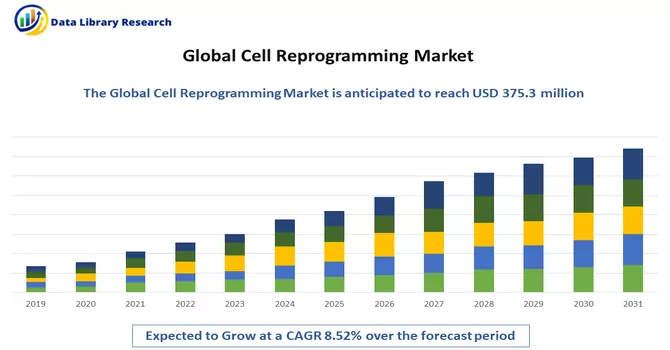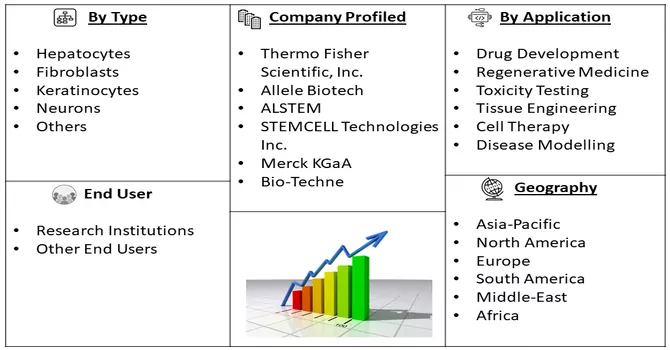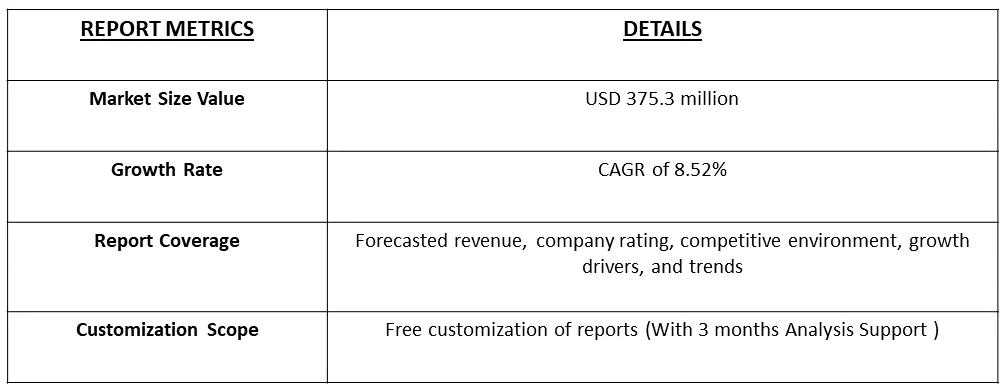The global market size for cell reprogramming was approximated at USD 375.3 million, with a projected compound annual growth rate (CAGR) of 8.52% anticipated from 2024 to 2030.

Get Complete Analysis Of The Report - Download Free Sample PDF
Cell reprogramming refers to the process of inducing specialized cells to revert to a more primitive or pluripotent state, where they regain the capacity to differentiate into various cell types. This transformation is typically achieved by introducing specific genetic factors or manipulating the cellular microenvironment. The most well-known example of cell reprogramming is the generation of induced pluripotent stem cells (iPSCs), which are created by reprogramming adult cells, such as skin or blood cells, back into a pluripotent state similar to embryonic stem cells.
The expansion of the global market is driven by an increasing focus on cell reprogramming technology, its growing adoption in cancer research, and a notable trend towards collaboration and partnerships among key industry players. The COVID-19 pandemic has played a positive role in influencing market growth. The heightened interest in cell reprogramming research and development during the pandemic stems from its potential application in developing novel treatments for COVID-19 and associated complications. Notably, in August 2020, the University of Minnesota initiated a clinical trial, marking the treatment of the inaugural patient with a new cell therapy designed to assess its effectiveness against COVID-19.
As the global healthcare landscape continues to emphasize personalized treatment approaches, there is a growing demand for cell reprogramming technologies. These technologies enable the generation of patient-specific induced pluripotent stem cells (iPSCs), supporting the development of personalized cell therapies. Also, the global cell reprogramming market is witnessing a surge in investments, driven by the expanding field of regenerative medicine. Governments, private investors, and pharmaceutical companies are allocating substantial resources to research and development activities focused on harnessing the potential of reprogrammed cells for therapeutic applications. Thus, these market trends are expected to contribute to the studied market growth.
Market Segmentation: The Global Cell Reprogramming Market is Segmented by Derived Cell Type (Hepatocytes, Fibroblasts, Keratinocytes, Neurons, and Others), Application (Drug Development, Regenerative Medicine, Toxicity Testing, Tissue Engineering, and Cell Therapy and Disease Modelling), End User (Research Institutions and Other End Users) and Geography (North America, Europe, Asia-Pacific, Middle East and Africa and South America). The report offers the value (in USD million) for the above segments.

For Detailed Market Segmentation - Download Free Sample PDF
Market Drivers
Increase in Research and Development Activities in Stem Cells Therapies
The surge in research studies focused on induced pluripotent stem cells (iPSCs) stands out as a primary driver for the growth of the market. An illustrative example is a study conducted by Indiana University, as of May 2022, in collaboration with the University of Alabama at Birmingham and five other institutions. This research delved into innovative regenerative medicine techniques targeting vascular health complications associated with retinal vessels in type 2 diabetes. The findings revealed that a specific mesoderm subgroup derived from hiPSCs can be safely and effectively utilized as a therapeutic option for rescuing ischemic tissues and repairing blood vessels in individuals with vascular disorders.
Moreover, the genetic transformation of peripheral blood cells from diabetic and non-diabetic subjects into hiPSCs, followed by maturation into distinctive blood vessel reparative cells, showed promising results in animal models of type 2 diabetes, indicating significant improvement in visual acuity and electroretinograms. Consequently, the demonstrated efficacy of iPSCs in treating retinal impairment in diabetic patients has propelled their utilization in study design and cell therapy for human disorders, thereby fostering market growth.
Surge in Adoption of Personalized Medicine
The market is buoyed by escalating government funding initiatives aimed at promoting the production of stem cell-based therapies for various diseases and establishing stem cell research centres. A case in point is the Stem Cell Therapies (SCT) Mission, which, as of March 2022, invested USD 150 million in developing novel, secure, and efficient stem cell therapies to enhance health outcomes, according to the Australian Government Department of Health and Aged Care. This mission's funding supports initiatives that contribute to the development of innovative and safe medical therapies, thereby fostering the growth of the stem cell reprogramming market. Furthermore, the market is witnessing increased company activities focused on developing regenerative medicines using iPSCs. For instance, SQZ Biotechnology Company achieved the generation of dopaminergic neurons from human iPSCs in June 2022. The company utilized its proprietary Cell Squeeze technology for the single-step delivery of six RNA-encoding specific fate-determining transcription factors. These developments not only contribute to the company's ongoing regenerative medicine research but also support its NIH-funded initiative targeting cell replacement therapeutics for neurological diseases, including Parkinson's disease. Such strides in industry activities are playing a pivotal role in propelling the growth of the iPSC market segment.
Market Restraints
Lack of Awareness Regarding Stem Cell Therapies and High Cost of Treatment
The high cost of stem cell treatments, including cell reprogramming therapies, poses a substantial barrier to widespread adoption. The intricate processes involved in reprogramming cells, along with the rigorous quality control standards associated with clinical-grade stem cells, contribute to the elevated costs of these treatments. Additionally, the need for specialized equipment, skilled personnel, and adherence to stringent regulatory requirements further adds to the financial burden. The result is limited accessibility for a broader patient base, potentially excluding individuals who could benefit from these transformative therapies. Thus, the above-mentioned factors are expected to slow down the growth of the studied market over the forecast period.
The healthcare sector faced substantial challenges during the COVID-19 pandemic, leading to the postponement of chronic therapies and restrictions on outpatient treatments to minimize the risk of viral transmission. Amid these challenges, studies on cell therapies have highlighted their potential in modulating the immune response, exerting control over cell function, and downregulating inflammatory cytokines. This has proven beneficial in mitigating the mortality and morbidity rates of COVID-19 patients. For instance, an article published in Molecular Biomedical in February 2022 emphasized the promising outcomes of stem cell-based clinical studies in altering the immune system to effectively treat COVID-19. The findings underscore the potential of cell therapies in contributing to better patient outcomes during the pandemic. The increased utilization of stem cells in such therapeutic and research contexts has driven significant growth in the market during the pandemic. This underscores the resilience and adaptability of cell-based therapies in addressing the unique challenges posed by COVID-19, showcasing the potential for continued advancements in the field.
Segmental Analysis:
Hepatocytes Segment is Expected to Witness Significant Growth Over the Forecast Period
Hepatocytes, as specialized cells constituting the majority of the liver tissue, play a pivotal role in various physiological functions, including metabolism, detoxification, and protein synthesis. The field of cell reprogramming has increasingly garnered attention for its potential to generate hepatocytes from different cell types, presenting a promising avenue for liver disease research, drug development, and regenerative medicine. Cell reprogramming involves the transformation of one cell type into another, and in the context of hepatocytes, this process holds significant therapeutic potential. Induced pluripotent stem cells (iPSCs) have been successfully differentiated into hepatocyte-like cells through a controlled and sequential process that mimics natural liver development. This technique provides a scalable and potentially limitless source of hepatocytes for various applications. Thus, owing to the above-mentioned advantages, the segment is expected to witness significant growth over the forecast period.
Tissue Engineering Segment is Expected to Witness Significant Growth Over the Forecast Period
Cell reprogramming techniques, such as induced pluripotent stem cell (iPSC) technology, provide a diverse and abundant source of cells for tissue engineering. These cells can be derived from a patient's cells, minimizing the risk of immune rejection and offering a personalized approach to tissue regeneration. Cell reprogramming allows the customization of cell types to suit specific tissue engineering needs. Through controlled differentiation protocols, reprogrammed cells can be directed to become various cell types, including cardiomyocytes, hepatocytes, or neurons, depending on the target tissue. This flexibility is crucial for creating complex tissues with diverse cell compositions. Thus, owing to such advantages, the segment is expected to witness significant growth over the forecast period.
North America Region is Expected to Witness Significant Growth Over the Forecast Period
North America emerged as the dominant force in the market, commanding a substantial share, due to the presence of key industry players, bolstering North America's position as a leader in terms of revenue generation. The region is characterized by dynamic business activities, with companies actively pursuing various initiatives to propel industry growth. A noteworthy example is the strategic collaboration announced in July 2023 between Stem Genomics SAS and Pluristyx, Inc., involving an equity investment and partnership in Stem Genomics. This strategic alliance is designed to offer an efficient approach, allowing customers to evaluate the genomic robustness of Pluripotent Stem Cell (PSC) lines from Pluristyx. Leveraging the iCS-digital PSC assay developed by Stem Genomics, the collaboration aims to enhance the assessment capabilities of Pluristyx's PSC lines. This initiative reflects the ongoing efforts within the region to drive innovation and strengthen the competitive landscape of the industry. Thus, the region is expected to witness significant growth over the forecast period.

Get Complete Analysis Of The Report - Download Free Sample PDF
To fortify their market presence, key industry players are implementing diverse strategic initiatives. These endeavours serve to bolster their business channels effectively. The collaboration between key market players is designed to streamline the scalable, consistent, and cost-efficient manufacturing of stem cell-derived products intended for patient applications. Some of the key market players working in this market segment are:
Recent Developments:
1) In November 2022, a 5-year agreement was established between Prepare Labs and Ncardia, aiming to expedite drug discovery and development across various stages, including target identification, lead optimization, toxicity assessment, and trial design. This collaborative effort involves enhancing induced pluripotent stem cells (iPSCs) by reprogramming adult cells, such as skin and blood cells, into a state resembling embryonic stem cells, capable of differentiating into any human body cell type.
2) In October 2022, the CiRA Foundation and the Cell and Gene Therapy Catapult (CGT Catapult) jointly initiated a research project focusing on the characterization of induced pluripotent stem (iPS) cells. The primary goal of this collaborative effort is to advance the application of iPS cell technologies in the development of products for regenerative medicine.
Q1. How big is the Cell Reprogramming Market?
The global market size for cell reprogramming was approximated at USD 375.3 million, with a projected compound annual growth rate (CAGR) of 8.52% anticipated from 2024 to 2030.
Q2. At what CAGR is the Cell Reprogramming Market projected to grow within the forecast period?
Cell Reprogramming Market is expected to grow at a compound annual growth rate (CAGR) of 8.52% over the forecast period.
Q3. Who are the key players in Cell Reprogramming Market?
Some key players operating in the market include
Q4. Which Region is expected to hold the highest Market share?
North America region is expected to hold the highest Market share.
Data Library Research are conducted by industry experts who offer insight on industry structure, market segmentations technology assessment and competitive landscape (CL), and penetration, as well as on emerging trends. Their analysis is based on primary interviews (~ 80%) and secondary research (~ 20%) as well as years of professional expertise in their respective industries. Adding to this, by analysing historical trends and current market positions, our analysts predict where the market will be headed for the next five years. Furthermore, the varying trends of segment & categories geographically presented are also studied and the estimated based on the primary & secondary research.
In this particular report from the supply side Data Library Research has conducted primary surveys (interviews) with the key level executives (VP, CEO’s, Marketing Director, Business Development Manager and SOFT) of the companies that active & prominent as well as the midsized organization
FIGURE 1: DLR RESEARH PROCESS

Extensive primary research was conducted to gain a deeper insight of the market and industry performance. The analysis is based on both primary and secondary research as well as years of professional expertise in the respective industries.
In addition to analysing current and historical trends, our analysts predict where the market is headed over the next five years.
It varies by segment for these categories geographically presented in the list of market tables. Speaking about this particular report we have conducted primary surveys (interviews) with the key level executives (VP, CEO’s, Marketing Director, Business Development Manager and many more) of the major players active in the market.
Secondary ResearchSecondary research was mainly used to collect and identify information useful for the extensive, technical, market-oriented, and Friend’s study of the Global Extra Neutral Alcohol. It was also used to obtain key information about major players, market classification and segmentation according to the industry trends, geographical markets, and developments related to the market and technology perspectives. For this study, analysts have gathered information from various credible sources, such as annual reports, sec filings, journals, white papers, SOFT presentations, and company web sites.
Market Size EstimationBoth, top-down and bottom-up approaches were used to estimate and validate the size of the Global market and to estimate the size of various other dependent submarkets in the overall Extra Neutral Alcohol. The key players in the market were identified through secondary research and their market contributions in the respective geographies were determined through primary and secondary research.
Forecast Model
